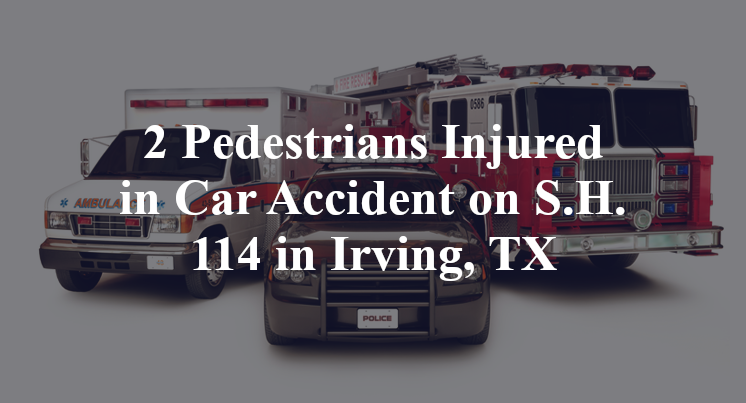2 Pedestrians Injured in Car Accident on S.H. 114 in Irving, TX
Dallas County, TX — January 11, 2025, two pedestrians were injured in a car accident at approximately 12:15 a.m. along State Highway 114.
According to authorities, two men ages 20 and 23 were on foot in the southeast bound lanes of S.H. 114 at the Northwest Highway junction when the accident took place.

Officials indicate that, for reasons yet to be confirmed, a collision took place between a southeast bound Hyundai Sonata, a vacant Honda Accord that had apparently been stalled in the active southeast lanes of the highway, the two pedestrians, and two other southbound vehicles.
The 20-year-old man reportedly sustained serious injuries due to the wreck. The other pedestrian may have suffered injuries, as well. Additional details pertaining to this incident—including the identities of the victims—are not available at this point in time. The investigation is currently ongoing.
Commentary by Attorney Michael Grossman
When multiple vehicles and pedestrians are involved in a collision on a major highway, especially in the early morning hours, it’s easy to assume that the chain of events must have stemmed from a breakdown in visibility or simple driver error. But a crash as complex as this one in Dallas County—reportedly involving a stalled vehicle, two pedestrians, and several moving cars—demands far more scrutiny. To understand how and why something like this occurred, we have to start with three critical questions.
First, did investigators conduct a full and detailed analysis of the crash scene? When a stalled vehicle sits in a live traffic lane and multiple parties become involved, the timing, vehicle positions, lighting conditions, and visibility all become essential to understanding fault and causation. Was the stalled Honda Accord visible from a safe distance? Were there flares, hazard lights, or other warnings? Did any of the other vehicles have time—or space—to maneuver around it? Without a precise reconstruction of how each vehicle and pedestrian entered the scene, assumptions about how the crash unfolded can quickly become unreliable.
Second, has anyone considered whether mechanical failures might have played a role? A stalled vehicle in a highway lane is often attributed to driver neglect, but sometimes the root cause is a sudden mechanical failure—a battery issue, fuel system failure, or powertrain problem that may not have given the driver time to pull safely to the shoulder. Similarly, the involved vehicles—including the Hyundai Sonata—should be inspected for braking system integrity, steering response, and whether their safety systems functioned as designed. These inspections are often overlooked in multi-vehicle crashes unless someone knows to ask for them before the vehicles are released.
Finally, has all available electronic and video data been gathered? In a crash involving multiple moving vehicles and pedestrians, electronic data recorders (EDRs) from each involved car are key to understanding who was braking, steering, or accelerating—and when. Dashcams, traffic cameras, and even cell phone location data from the pedestrians could help construct an accurate timeline and assess whether those on foot were attempting to aid a stalled vehicle or avoid traffic. This level of detail is often what separates a guess from a true understanding of how a crash occurred.
Answering these three questions is critical to making sure that no stone is left unturned in understanding the causes of a crash like this. Serious wrecks deserve serious investigation, not assumptions. Getting clear answers to these questions is crucial for those seeking to understand what happened and why—and it's the least that can be done to help those affected find the clarity and closure they deserve.

*We appreciate your feedback and welcome anyone to comment on our blog entries, however all visitor blog comments must be approved by the site moderator prior to showing live on the site. By submitting a blog comment you acknowledge that your post may appear live on the site for any visitors to see, pending moderator approval. The operators of this site are not responsible for the accuracy or content of the comments made by site visitors. By submitting a comment, blog post, or email to this site you acknowledge that you may receive a response with regard to your questions or concerns. If you contact Grossman Law Offices using this online form, your message will not create an attorney-client relationship and will not necessarily be treated as privileged or confidential! You should not send sensitive or confidential information via the Internet. Since the Internet is not necessarily a secure environment, it is not possible to ensure that your message sent via the Internet might be kept secure and confidential. When you fill out a contact or comment form, send us an email directly, initiate a chat session or call us, you acknowledge we may use your contact information to communicate with you in the future for marketing purposes, but such marketing will always be done in an ethical way.